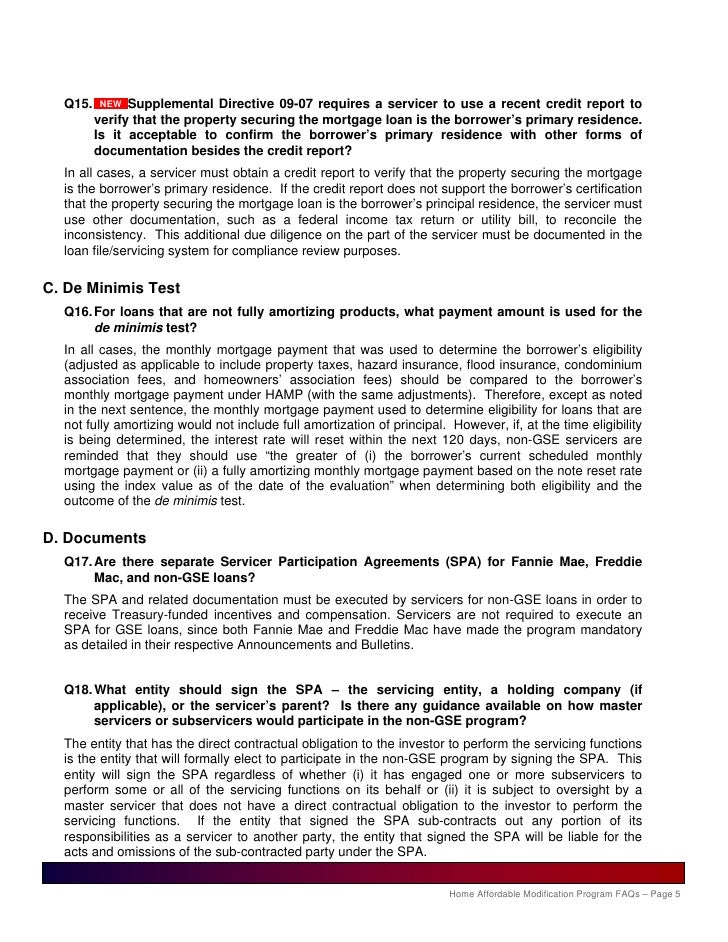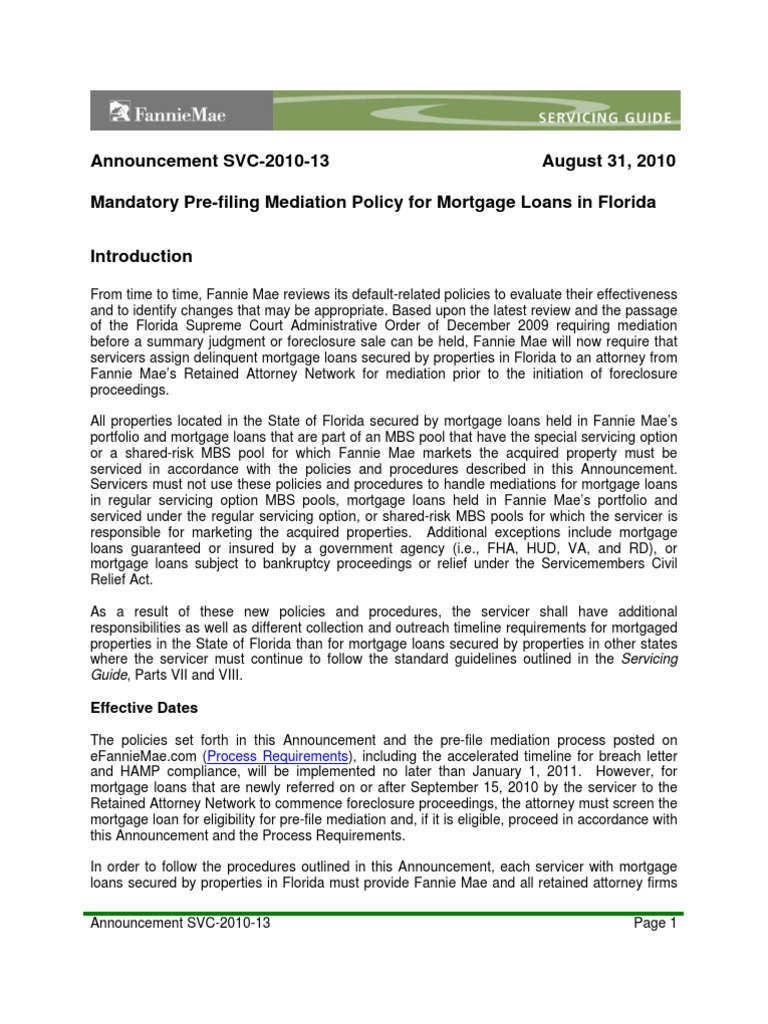Fannie Mae Hamp Program Guidelines
In a loan modification, the bank agrees to alter your mortgage terms, which in turn lowers your monthly payment to a more affordable amount. If Fannie Mae or Freddie Mac own your loan, you might qualify for a Flex Modification, which is a special loan modification program. Under this program, the loan servicer takes a series of steps, which may include lowering the interest rate and/or extending the term of the loan, to lower your monthly payments. (To learn what to do—and what not do—in the loan modification process, read Do’s and Don’ts for Getting a Loan Modification.)
- Hamp Mortgage Modification Program
- Fha Hamp Loan Modification Guidelines
- Hamp Mortgage Program Guidelines
Mortgages may be previously modified, but can only be modified once under HAMP. Borrowers may be eligible for this program if they meet the following requirements: Borrowers may be considered for a HAMP Trial Period if they are current or less than 60 days delinquent and determined to be in imminent default, or 60 days or more delinquent. The HAMP Solution Center phone line 1(866) 939 - 4469 will no longer be in service effective July 1st, 2019. Memorial Day Holiday Support and System Availability.
Read on to learn who (or what) Fannie Mae and Freddie Mac are, how the Flex Modification program works, who’s generally eligible for this type of modification, and what you can do if you don’t qualify for the program.
Parties Involved in Mortgage Servicing
Before you can understand who or what Fannie Mae and Freddie Mac are, you first must understand the basic parties involved in mortgage servicing.
Lender or originator. A lender or originator is the party that loaned you the money for your home loan.
Investor. Often, the originator— the original owner of the loan—subsequently sells the loan to a new owner, who is called an investor.
Servicer. A servicer is the company that handles the loan account. The servicer collects and processes the monthly payments, manages the escrow account (if there is one), processes loan modification applications, and supervises the foreclosure process when borrowers don’t make their payments. Sometimes, the loan owner also acts as the servicer. Other times, the owner sells the right to service the loan to another company.

Who or What Are Fannie Mae and Freddie Mac?
The Federal National Mortgage Association (FNMA), also called “Fannie Mae,” and the Federal Home Loan Mortgage Corporation (FHLMC), also called “Freddie Mac,” are government-sponsored enterprises that own or back (guarantee) many mortgages in the United States.

Here’s how Fannie Mae and Freddie Mac play a role in the mortgage market:

A borrower usually takes out a loan to buy a home from a bank or mortgage company. Most of the time, though, the original lender won’t keep the loan. Instead the lender sells the loan to a bank or investor—like Fannie Mae or Freddie Mac—on what’s commonly known as the secondary mortgage market. After purchasing a loan from a bank or mortgage company, Fannie Mae or Freddie Mac either keep the mortgage in their portfolio or package the loan with other loans into mortgage-backed securities, which are then sold to private investors. Fannie Mae and Freddie Mac sometimes guarantee the loans that they sell to investors, which means they make sure that an investor gets paid on the loan even if the borrower defaults. (Learn more about Fannie Mae and Freddie Mac.)
How Flex Modifications Work
The Flex Modification program helps borrowers who have Fannie Mae and Freddie Mac owned loans. A Flex Modification, which replaces the now-expired Home Affordable Modification Program (HAMP) program, is supposed to reduce an eligible borrower’s mortgage payment by about 20%.
With a Flex Modification, the servicer has to take one or more of the following steps to lower the borrower's payment:
- capitalize the overdue amounts (“capitalizing” the overdue amounts means adding them to the outstanding loan amount)
- adjust the interest rate
- extend the term of the loan, or
- forbear some of the principal balance. (“Forbearing” the principal means setting aside a portion of the total debt before calculating the borrower’s monthly payment. The borrower typically has to pay the set-aside portion in a balloon payment when refinancing or selling the home, or when the loan matures.)
Both Fannie Mae and Freddie Mac require their servicers to review all borrowers for a Flex Modification when the borrower is between 90 and 105 days behind in payments. So, your servicer might offer you this type of modification, even if you don't apply for it. Though you can also apply, as long as a foreclosure sale hasn't happened yet. (Under federal law, if you submit your complete application more than 37 days before a scheduled foreclosure sale, the foreclosure must be delayed while the application is pending.)
Before the servicer finalizes the modification, you’ll have to successfully complete a trial period plan that normally lasts three or four months. If you make all of the trial payments, you’ll get a permanent loan modification that likely waives previous late charges, penalties, and other fees.
Eligibility for a Flex Modification
To be eligible for a Flex Modification, Fannie Mae or Freddie Mac must own your loan. (To find out if either Fannie Mae or Freddie Mac owns your loan, call your mortgage servicer or use the Fannie Mae and Freddie Mac online loan lookup tools.)
Also, you, your home, and your mortgage loan have to meet specific criteria, like:
- the loan must be a conventionalfirst mortgage and
- you must have taken out your mortgage at least 12 months before being evaluated for a Flex Modification.
The requirements to get this type modification are rather extensive and complicated, so call your mortgage servicer to find out if you qualify and to learn how to apply.
Keygen php maker template. You can click on the tab to view the list of fields that are not supported. The Field Setup pages consists of two section.
What If Fannie Mae or Freddie Mac Doesn’t Own My Loan?
Even if Fannie Mae or Freddie Mac doesn’t own your loan—or if you don’t qualify for a Flex Modification for some other reason—you might qualify for another modification program through your servicer. Servicers and investors normally offer their own in-house (called “proprietary”) modifications, as well as forbearance agreements and repayment plans to help borrowers who are behind in mortgage payments.
To learn about the different options that might be available to you, call your loan servicer.
Getting Help
If you need help working out a modification or another way to avoid foreclosure with your loan servicer, consider contacting a foreclosure attorney or a HUD-approved housing counselor.
Click here to get more information about the Flex Modification program if you have a Fannie Mae loan. If you have a Freddie Mac loan, go here.
Fannie Mae and Freddie Mac offer loan modifications to eligible troubled borrowers so they can avoid foreclosure and stay in their homes. Your options might include a Flex Modification, which replaces the Home Affordable Modification Program (HAMP) that ended in December 2016, or another type of modification, in some cases.
Read on to learn more.
What’s a Modification?
A loan modification is a permanent restructuring of the mortgage where one or more of the terms, like the length of the loan or the interest rate, are changed to provide a more affordable payment.
A modification might be right for you if:
- you aren’t eligible to refinance your loan
- you’re facing a long-term hardship (but you could afford to make modified payments), or
- you’re a few months behind on your mortgage payments or you’re likely to fall behind sometime soon.
As part of a modification, any past-due amounts are usually added to the outstanding principal balance and then reamortized over the new term. (To learn more about modifications, see How to Get a Mortgage Loan Modification.)
Fannie Mae and Freddie Mac Modification Programs
In the past, Fannie Mae and Freddie Mac offered standard and streamlined modifications to people. Those programs, along with HAMP, were replaced on October 1, 2017 with the Flex Modification program.
Hamp Mortgage Modification Program
Under this program, the loan servicer takes a series of steps, which might include lowering the interest rate and extending the term of the loan, for example, to reduce the borrower’s monthly payments. The Flex Modification program offers servicers more flexibility than HAMP did when it comes to evaluating borrowers. With HAMP, lenders could adjust a borrower’s loan terms until the mortgage payment equaled 31% of the borrower’s income. A Flex Modification will, on the other hand, reduce a borrower's monthly mortgage payments by about 20%.
While the Flex Modification program uses similar measures as HAMP to modify a loan, the program permits the servicer to consider how delinquent the borrower is, as well as the home’s value, in the process. (To learn more about Flex Modifications, see The Fannie Mae and Freddie Mac Flex Modification Program for Homeowners: What You Should Know.)
Fha Hamp Loan Modification Guidelines
How to Find Out If Fannie Mae or Freddie Mac Owns Your Loan
If Fannie Mae or Freddie Mac is the owner of your loan, you might be eligible for a Flex Modification. To find out if either of these entities owns your loan, call your servicer or use the Fannie Mae and Freddie Mac online loan lookup tools.
Hamp Mortgage Program Guidelines
How to Find Out About Modification Options
If you want to find out about modification options, call your servicer as soon as possible so you can be evaluated for an alternative to foreclosure that is appropriate for your situation.
Getting Help
If you need help applying for a modification, have questions about the loss mitigation process, or are having problems dealing with your servicer, consider talking to a foreclosure attorney or a HUD-approved housing counselor. You should, however, avoid loan modification companies.